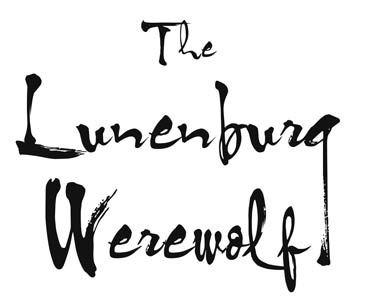The Lunenburg Werewolf
Read The Lunenburg Werewolf Online
Authors: Steve Vernon
Tags: #FICTION / Ghost, #HISTORY / Canada / General



And
Other
Stories
of
the
Supernatural
Steve Vernon

Copyright © 2011, Steve Vernon
All rights reserved. No part of this book may be reproduced, stored in a retrieval system or transmitted in any form or by any means without the prior written permission from the publisher, or, in the case of photocopying or other reprographic copying, permission from Access Copyright, 1 Yonge Street, Suite 1900, Toronto, Ontario M5
E
1
E
5.
Nimbus Publishing Limited
3731 Mackintosh St, Halifax,
NS B
3
K
5
A
5
(902) 455-4286 nimbus.ca
Library and Archives Canada Cataloguing in Publication
Vernon, Steve
The Lunenburg werewolf : and other stories of the
supernatural / Steve Vernon.
ISBN 978-155109-886-9
1. Ghost stories, Canadian (English)âNova Scotia.
2. GhostsâNova Scotia. Â 3. FolkloreâNova Scotia. Â 4. Haunted placesâNova Scotia. Â 5. Nova ScotiaâHistory. Â I. Title.
BF1472.C3V474 2011 398.209716 C2011-903914-1
Nimbus Publishing acknowledges the financial support for its publishing activities from the Government of Canada through the Canada Book Fund (
CBF
) and the Canada Council for the Arts, and from the Province of Nova Scotia through the Department of Communities, Culture and Heritage.

The Lady in Blue (Peggy's Cove)
Murder Island Massacre (Yarmouth)
The Phantom Ship of the Northumberland Strait (Pictou Island)
The Mare of McNabs Island (Halifax)
The Kentville Phantom Artist (Kentville)
Beast of the Black Ground (Grande Anse)
The Mark of the Fish (Port Hood)
The Sight of the Stirring Curtains (Digby)
Aunt Minnie's Black Cat (Cleveland)
The Haunting of Esther Cox (Amherst)
The Lunenburg Werewolf (Lunenburg)
The Capstick Bigfoot (Capstick)
The Ghosts of Oak Island (Oak Island)
The Fires of Caledonia Mills (Caledonia Mills)
The Tale of the Screeching Bridge (Parrsboro)
Three Selkies for Three Brothers (Cape Breton)
Ivy Clings to this Lodge (White Point)
Mrs. Murray's Five Crying Babies (New Glasgow)

I'd like to thank Conrad Byers âstoryteller, folklorist, and historian from Parrsboro, Nova Scotiaâfor his invaluable help with “The Tale of the Screeching Bridge.”
I'd also like to thank the folks at White Point Beach Resort for inviting me to tell some Halloween stories and for the help they gave me with Ivy's story.
I'd like to thank the folks at Nimbus for the faith they continue to show in my work.
And lastly, as always, I'd like to thank my wife, Belinda, for putting up with me all these years. I could not believe in me if not for thee.


A story, at the heart of it, is an answer to a question.
One question I often hear as a storyteller is, “Why do you tell so many ghost stories?” I will be honest. I have never claimed to be a seeker of ghosts. You will not find me hunkered down in a haunted house with an ion counter in one hand, an infrared thermal scanner in the other, and a video camera clenched between my chattering teeth. I am afraid that I am far too lazy for such flagrant adventure. I am nothing more than a storyteller. I weave both history and folklore into the fabric of my yarning in an attempt to entertain whoever has gathered close to the campfire. I am not a historian but I attempt to keep as close to the truth of the matter as humanly possible.
So why ghost stories, then?
I usually answer the question by telling people how I used to listen to my grandfather's stories when I was a boy. I liked his railroad stories, his hunting stories, and his fishing stories, but I loved his ghost stories best. As soon as I heard the rattle of a skeleton, the clatter-clatter of a rusty graveyard chain, or the creaking of a vampire's coffin my ears perked up and opened wide. Ask any kid you knowâghosts are cool.
There is a great tradition of ghost stories here in Nova Scotia. You will find these stories carved in rock, rooted in timber, poured into the water, and wafting through the air that we breathe. The tales are many and varied, ranging from legends of buried pirate treasure, stories of eerie haunted houses and poltergeist pranks, and yarns of mermaids, selkies, and the spirits of the unavenged dead seeking out justice long after the grave has claimed their bones. I tell ghost stories to honour and keep alive this ancient gentle tradition.
One other question that I am asked frequently is, “When are you going to write another collection of Nova Scotian ghost stories?” Well, my first collection,
Haunted Harbours
, has done very well. So it certainly is time for a follow-up to that volumeâand you are holding it right here in your clammy little hands.
For this collection I tried to touch on some of the older and more well-known tales, such as the mystery of Oak Island, the tale of the Mary Ellen Spook House in Caledonia Mills, and the haunting of poor Esther Cox of Amherst. Yet I have also spared no effort to unearth some of the lesser-known ghostly yarns of Nova Scotia, such as the tale of the Lunenburg werewolf and the Port Hood story “The Mark of the Fish.” Each of the two dozen tales contained in this volume is based on folklore and history that people have been passing around this province for the last two hundred years. The word “story” is just another term for the art of sharing experience. So let my words help you to share the experiences of people from long ago as they attempt to come to grips with the mysteries of the unknown.
From the moment you strike up a conversation with another human being you invariably find yourself talking in stories: “This is how it all got started.” “A funny thing happened today.” “You won't believe what my mother told me.” And so, let me tell you one last story.
I spend a lot of time every year working in Maritime schools through the Writers in the Schools program. I talk to hundreds of kids. I teach them about the shape of the story, how to choose a voice, and how to use that voice well. And then, at nearly every one of my workshops, I like to end with a ghost story. I finish each ghost story with those two wonderful words: “The end.”
And then, after I have said those two words the kids will almost always respond with two more: “Tell another.”
